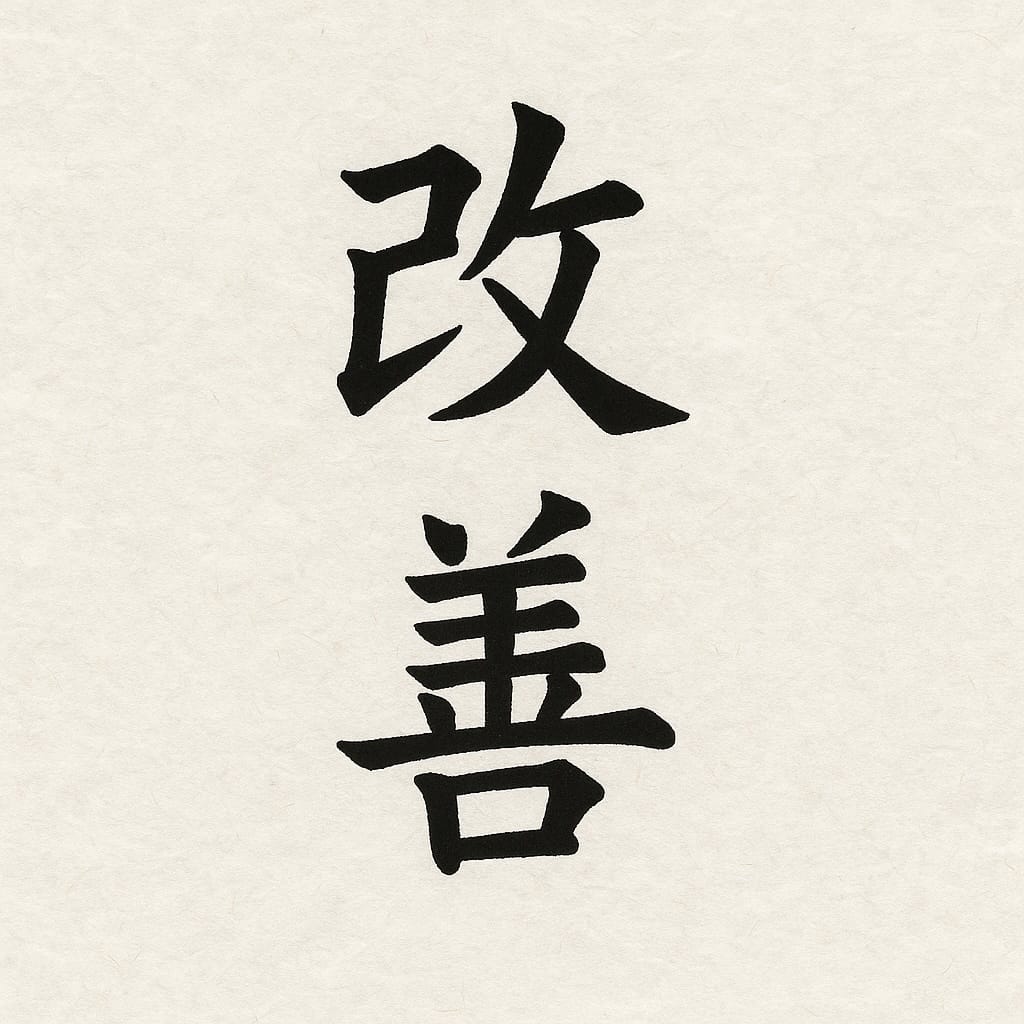Hi everyone,
I would like to introduce you to Personal Kaizen.
Although I teach a wide variety of practices in areas such as mindfulness, meditation, and personal resilience, I've realised that I haven't spent enough time helping people to build a practical framework to assist their overall progress. I have developed several teaching frameworks of my own, like Mindfulness-Based Resilience, Loving Awareness, The Energy Tree and The Frictionless Way. These frameworks group practices together in meaningful ways, but they don't address how you can advance your practice and personal development.
Personal development is the main reason people turn to meditation. If you search online for "personal development," you'll find plenty of resources aimed at elite high achievers, as well as more general coaching.
The closest I've come to recommending a personal development framework in the past is James Clear's *Atomic Habits*. Atomic Habits is the result of James Clear's research into the science of habit formation.
Before we begin with Kaizen, let's take a look at Atomic Habits, as there is an overlap between the two. The main difference is that Kaizen is more comprehensive and supportive.
James Clear and Atomic Habits
If you're on Instagram, I highly recommend following James Clear (@jamesclear). His Instagram is one of the clearest, most succinct, and most useful channels on social media.
James focuses on practical interventions, occasionally incorporating mindfulness topics. His core concept, outlined in his book *Atomic Habits*, is based on continuous improvement through tiny, sustainable changes. It's about building good habits and gradually reducing bad ones.
Incremental changes beat a Big Bang (change everything at once) approach every time for a whole lot of useful reasons.
The science of habit formation reveals that significant, sweeping changes—such as promising yourself to go to the gym every day or eliminating all processed foods—often fail because when things get difficult, we will drop them. Instead, focus on small adjustments.
These "atomic" habits compound over time and can lead to significant results.
Atomic Habits in Action
Consider your morning routine: You wake up stressed, brush your teeth, shower, and start your day. Everyone has at least two minutes to spare, so you can place a Post-it note on your bathroom mirror as a reminder. Then, practice two minutes of the 4-6 breathing practice (or any other useful breathwork practice) before brushing your teeth. This calms your body and mind in just two minutes.
In the shower, instead of ruminating, replace wandering thoughts with mantras or affirmations. The one I use in the shower is from Marcus Aurelius: "Each morning when I arise, I think what a precious privilege it is to live, to breathe, to enjoy, to love." I repeat it until I mean it. The shower takes the same amount of time, but now it's productive. These micro-habits—inserted into and in between existing routines—make small changes to what you already do, which makes change easier. Over time, these improvements compound, leading to a calmer mind, improved focus, and overall well-being.
Atomic habits are great, but for something more comprehensive, we can use the world's most widely used continuous improvement framework: Kaizen.

Kaizen
The Japanese art of Continuous Improvement.
Introducing Kaizen
Kaizen, which translates to "good changes," became famous when Toyota embedded it into its business processes and rose to become the most successful motor manufacturer in the world. An example of how Kaizen would be applied on a production line is that a mechanic might need to use a particular tool a few times each day. Instead of walking back and forth to a distant tool rack, a Kaizen approach would be to move the tool to a closer place—saving many back-and-forth journeys with one minor change of location.
Toyota rewarded workers when their suggestions were adopted. Over the years, this has contributed to Toyota being a global leader in manufacturing.And the company continues to innovate. Currently, they appear to be leapfrogging electric vehicles with hydrogen engines.
The beauty of Kaizen is its emphasis on small, often unnoticed improvements that accumulate to create large improvements. You might not see a difference day-to-day, but over time, the transformation is profound.
The 10 Principles of Kaizen
Kaizen has 10 founding principles, which I'll outline below. Although they have been developed for business processes, they apply perfectly well to the process of personal development, especially in meditation.
- Continuous Improvement (Atomic Habits): Make small, consistent enhancements. These lead to significant long-term results through compounding. One tiny change might seem insignificant, but when combined with others—such as optimising your daily routine—they amplify each other and lead to better outcomes.
- Customer Focus: *You* are the customer. With every change, ask: "How do I benefit?" Journaling can help you keep track of this. Don't adopt practices just because they're interesting—keep only those that directly improve your life, such as a technique that reduces stress or makes you feel focused, calmer, more neutral, or relaxed.
- Eliminate Waste: Examine your life for wasted time or effort. Remove it incrementally. If you doom-scroll on your mobile, compulsively watch the news, or engage in any other unhelpful activity, try cutting back gradually—say, drop afternoon scrolling while keeping the morning and evening sessions. Or replace the news with some history lessons. In meditation, refocus on your personal high-benefit practices. Apply the Stoic Principle: Focus on what you can influence and let go of the rest.
- Standardisation: Standardise your practices for consistency and comparison. Meditation has become diluted by the internet—many people just scroll YouTube for guided imagery. That's fine, but it's more useful to integrate and repeat your own practice. That way, you can observe improvements and changes. For instance, do two minutes of 4-6 breathing (four seconds in, six seconds out) every morning. Over time, you can evolve it to extended pranayama. Without consistency, meditation can become just another distraction.
- Employee Involvement: Engage your "Inner team"—you and your supporters. At the end of a calm meditation, ask: "Do I really want this? What do I want instead?" Write answers in a journal; they're not absolute, as they may change. Include external support, like mentoring sessions from my Deepening course or from our meditation community.
- Teamwork: This is your external team. For my students, this is our meditation community. Logging into classes or attending on Saturdays helps build your connection. When we meditate together, we support each other's progress.
- Process Over Outcome: An ancient principle from the Bhagavad Gita is to focus on perfecting the action itself, rather than chasing the outcome. In football, the goal is to win, but you achieve it by improving processes—like practising set pieces or positioning repeatedly. In meditation, we repeat the process: the mind wanders, we notice, and then return to our breath. The "I'll be calm" improvement will come unannounced, like a player becoming a champion without realising it mid-practice.
- Data-Driven Decisions: Use a meditation journal. I practice what I teach. My notes app has over 15,000 entries, tagged and searchable. For Kaizen, I've mentioned it in a few places, like a 2019 podcast ("Meditation the Modern Way"). If you journal, you can track what works and what doesn't, and then make informed choices based on real data.
- Flexibility and Adaptability: Avoid rigid frameworks that limit your options, such as the belief that you *must* meditate for 30 minutes each morning. Find times and practices that draw you in naturally. Then, in adversity, you can be flexible and adjust to retain your practices under pressure.
- Discipline and Consistency (with a Focus on Consistency): Discipline is overused in meditation teaching. Prioritise consistency: Ask yourself if your practice is steady. If not, make some small adjustments without forcing it. Over time, the practices become part of you—you *express* them, especially in adversity, rather than just doing them mechanically.

Kaizen and Meditation
Applying Kaizen to Meditation
Kaizen ties everything together: atomic habits for small changes, journaling for tracking, and community for support. Successful meditation is achieved by building a practice that evolves naturally, focusing on its benefits, eliminating distractions, and standardising routines. The principles reinforce one another, forming a self-sustaining and supportive framework.
Remember, this isn't about perfection—it's about good changes compounding over time. Start small: Add a two-minute breath to your routine, journal one insight per session, and engage with the community. After months or years, you'll notice profound growth.
Conclusion
Kaizen is: Process over Perfection and Process over Outcome. Kaizen is about polishing the process until it delivers you what you need.
Kaizen offers the most robust framework for personal development in meditation. It's not flashy, but its principles—continuous improvement, customer focus, process over outcomes and the rest—are transformative. Combined with ideas like atomic habits, it provides a path to lasting progress. If you're ready, grab a journal and start applying one principle today. Your future self will thank you.

